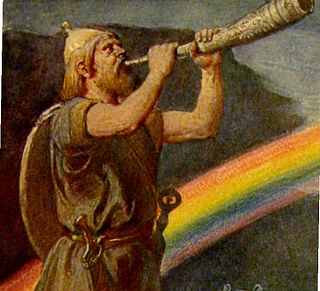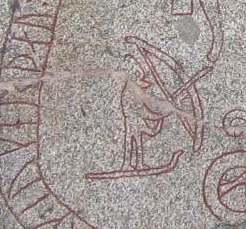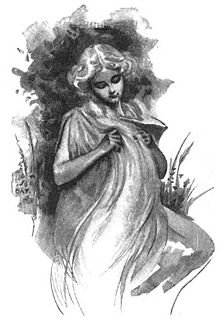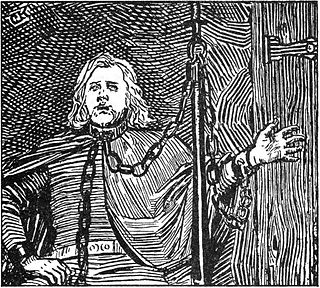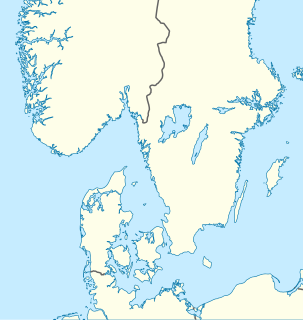
In Norse mythology, the megingjörð (meaning "power-belt" [1] in Old Norse) is a belt worn by the god Thor. The Old Norse name megin means power or strength, and gjörð means belt.

Norse mythology is the body of myths of the North Germanic peoples, stemming from Norse paganism and continuing after the Christianization of Scandinavia, and into the Scandinavian folklore of the modern period. The northernmost extension of Germanic mythology, Norse mythology consists of tales of various deities, beings, and heroes derived from numerous sources from both before and after the pagan period, including medieval manuscripts, archaeological representations, and folk tradition.

Old Norse was a North Germanic language that was spoken by inhabitants of Scandinavia and their overseas settlements from about the 9th to the 13th century.
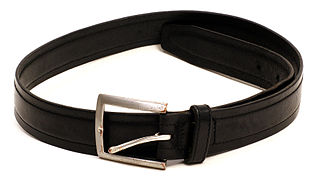
A belt is a flexible band or strap, typically made of leather or heavy cloth, and worn around the waist, which is usually of less circumference than the hips underneath, preventing pants from falling. Belts are used to secure or hold up clothing, like trousers or other articles of clothing, in a manner similar to suspenders and garters. Some trousers come with belt loops around the waist, which the belt goes through. Objects to carry objects such as coin purses, holsters, scabbards, inrōs, etc. have been attached to belts in lieu of pockets.
According to the Prose Edda , the belt is one of Thor's three main possessions, along with the hammer Mjölnir and the iron gloves Járngreipr. When worn, the belt is described as doubling Thor's already prodigious strength.
The Prose Edda, also known as the Younger Edda, Snorri's Edda or, historically, simply as Edda, is an Old Norse work of literature written in Iceland in the early 13th century. The work is often assumed to have been written, or at least compiled, by the Icelandic scholar, lawspeaker and historian Snorri Sturluson around the year 1220.
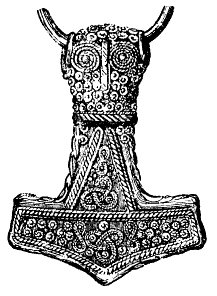
In Norse mythology, Mjölnir is the hammer of Thor, the Norse god associated with thunder. Mjölnir is depicted in Norse mythology as one of the most fearsome and powerful weapons in existence, capable of leveling mountains. In its account of Norse mythology, the Prose Edda relates how the hammer's characteristically short handle was due to a mistake during its manufacture. Similar hammers (Ukonvasara) were a common symbol of the god of thunder in other North European mythologies.

In Norse mythology, Járngreipr or Járnglófar are the iron gloves of the god Thor. According to the Prose Edda, along with the hammer Mjölnir and the belt Megingjörð, Járngreipr is one of Thor's three crucial possessions. According to chapter 20 of the book Gylfaginning, he requires the gloves to handle his powerful hammer. The reason for this may come from the forging of the hammer, when the dwarf working the bellows was bitten in his eye by a gadfly which caused the handle of the hammer to be shortened.
In verse 7 of the skaldic poem Þórsdrápa (Thorsdrapa, Lay of Thor) written by the 10th-century poet Eilífr Goðrúnarson, in the service of Jarl Hákon Sigurðarson, refers to Thor's power-belt.
Þórsðrápa is a skaldic poem by Eilífr Goðrúnarson, a poet in the service of Jarl Hákon Sigurðarson. The poem is noted for its creative use of kennings and other metaphorical devices, as well as its labyrinthine complexity.
Eilífr Goðrúnarson was a late 10th-century skald, considered to be the author of the poem Þórsdrápa. He is also credited with Hákonar drápa jarls and a fragment remains of a poem with Christian allusions which is also believed to be his work. He was a court poet of Hákon the Powerful.
Harðvaxnar sér herðir
halllands of sik falla
(gatat maðr) njótr (hin neytri)
njarð- (ráð fyrir sér) gjarðar.
Þverrir lætr nema þyrri
Þorns barna sér Mǫrnar
snerriblóð til svíra
salþaks megin vaxa.
The line "njótr njarðgjarðar" literally means "he who benefits from the mighty belt", referring to Thor's magical belt/girdle of strength/power, Megingjörð.
In Gylfaginning, which is the first part of Snorri Sturluson's Prose Edda, after Prologue, verse 45 refers to Thor's power-belt.

Gylfaginning, is the first part of Snorri Sturluson's 13th century Prose Edda after Prologue. The Gylfaginning deals with the creation and destruction of the world of the Norse gods, and many other aspects of Norse mythology. The second part of the Prose Edda is called the Skáldskaparmál and the third Háttatal.

Snorri Sturluson was an Icelandic historian, poet, and politician. He was elected twice as lawspeaker to the Icelandic parliament, the Althing. He was the author of the Prose Edda or Younger Edda, which consists of Gylfaginning, a narrative of Norse mythology, the Skáldskaparmál, a book of poetic language, and the Háttatal, a list of verse forms. He was also the author of the Heimskringla, a history of the Norwegian kings that begins with legendary material in Ynglinga saga and moves through to early medieval Scandinavian history. For stylistic and methodological reasons, Snorri is often taken to be the author of Egil's saga.
A prologue or prolog from Greek πρόλογος prologos, from πρό pro, "before" and λόγος logos, "word" is an opening to a story that establishes the context and gives background details, often some earlier story that ties into the main one, and other miscellaneous information. The Ancient Greek prólogos included the modern meaning of prologue, but was of wider significance, more like the meaning of preface. The importance, therefore, of the prologue in Greek drama was very great; it sometimes almost took the place of a romance, to which, or to an episode in which, the play itself succeeded.
En er kom at dagan, þá gekk Þórr út ok sér mann, hvar lá skammt frá honum í skóginum, ok var sá eigi lítill. Hann svaf ok hraut sterkliga. Þá þóttist Þórr skilja, hvat látum verit hafði of nóttina. Hann spennir sik megingjörðum, ok óx honum ásmegin. Ok í því bili vaknar sá maðr ok stóð skjótt upp, en þá er sagt, at Þór varð bilt einu sinni at slá hann með hamrinum ok spurði hann at nafni.
The line "Hann spennir sik megingjörðum, ok óx honum ásmegin" means "He girded himself with his belt of strength, and his divine strength grew" ("He" being Thor).
